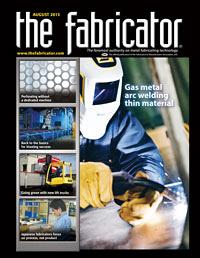- FMA
- The Fabricator
- FABTECH
- Canadian Metalworking
Categories
- Additive Manufacturing
- Aluminum Welding
- Arc Welding
- Assembly and Joining
- Automation and Robotics
- Bending and Forming
- Consumables
- Cutting and Weld Prep
- Electric Vehicles
- En Español
- Finishing
- Hydroforming
- Laser Cutting
- Laser Welding
- Machining
- Manufacturing Software
- Materials Handling
- Metals/Materials
- Oxyfuel Cutting
- Plasma Cutting
- Power Tools
- Punching and Other Holemaking
- Roll Forming
- Safety
- Sawing
- Shearing
- Shop Management
- Testing and Measuring
- Tube and Pipe Fabrication
- Tube and Pipe Production
- Waterjet Cutting
Industry Directory
Webcasts
Podcasts
FAB 40
Advertise
Subscribe
Account Login
Search
Fabricator breathes new life into internal combustion engines
Custom intake chambers improve airflow, boost horsepower
- By Eric Lundin
- August 9, 2013
- Article
- Arc Welding

Ariel Banco has helped to add horsepower to personal watercraft and airplanes, but his passion is where rubber meets the road—cars and motorcycles.
Few inventions have captured imaginations as thoroughly as the internal combustion engine. The key to mobility for the last century, the internal combustion engine provides a chance for the young (and young at heart) to modify, alter, and tweak, using every trick they can find to improve the engine’s performance.
Inspiration is everywhere, found in engines that vary wildly—top-fuel dragsters that burn nitromethane and develop 10,000 horsepower; Formula One engines that turn at nearly 18,000 revolutions per minute; and stock cars that have to endure grueling races, some up to 600 miles. Regardless of these differences, these engines have one thing in common: All of them move a lot of air, much more air than fuel. Gasoline engines run most efficiently at an air-to-fuel ratio around 13-to-1, also known as the stoichiometric ratio.
On most passenger vehicles, the air intake is passive. Each cylinder draws in the mixture of air and fuel on the intake stroke, pulling air in through the air filter. This is fine for not-too-exciting, day-to-day driving, but pressurizing the air outside the engine, thereby forcing it into the cylinders, can provide a big boost to the engine’s performance. This is the principle behind superchargers and turbochargers. They need a lot of air—a lot of air—preferably delivered to each intake valve at the right time. Routing air to each cylinder individually is a minor engineering exercise and a big fabrication hassle; an easy way to deliver a large quantity of air at a steady flow rate for all cylinders is to add a plenum, a large air chamber that forms part of the intake system. Custom-made plenums are so sought after that Ariel Banco started a company, Custom Plenum Creations, Wollongong, Australia, to cater to this market.
Steeped in automobile hobby work from a very young age, about 3 years old, Banco was introduced to engines, the tools used to take them apart, and the hard work needed to put them back together by his father. Motorbikes and automobiles have been his passion throughout his life, a passion so strong that a solid corporate career in accounting and finance was little more than a speed bump that slowed his progress for a while. Banco built his first manifold and posted some information about it online in the early 2000s, as Internet usage was growing, and before long he found himself dealing with a growing backlog. Working in the office all week and in the garage all weekend got to be a bit too much. When Banco realized that the plenums business was enough to support his family, he hung up his suits for the last time and launched Custom Plenum Creations.
His shop is outfitted with a lathe; guillotine shear; folding machine; hydraulic press; vertical and horizontal drop saws; tube bender; swager; and, in Banco’s words, his most important tool, a Kemppi MasterTig 2300MLS.
“It hit the spot right out of the box,” he said. “It works well for everything I do, welding plenty of aluminum and all types of steels.” Banco is self-taught in fabricating, including welding, having used the trial-and-error method to determine the best settings for the variety of metals and thicknesses he uses to make plenums.
Of course, a plenum isn’t just a nice-looking welded box. A good plenum requires a good understanding of airflow. Fluid dynamics is a complicated science, and, again, Banco is self-taught, augmented with plenty of flow bench time.
Banco’s business brings together three strong elements—his passion for automobiles, curiosity about how things work, and drive for perfection. The result is the best possible custom manifold, tailor-made for the application. Banco said his work consistently puts a smile on his customers’ faces, bumping up the horsepower between 5 and 10 percent. His marketing efforts have led to inquiries well beyond his initial market, street cars; he has fabricated plenums for motorcycles, airplanes, personal watercraft, and racing cars of all sorts.
Focused on the future, Banco keeps a database of customer information, which he updates regularly. Combined with his latest effort, learning 3-D modeling using a CAD system, the database helps Banco develop new product designs.
It’s a long way from a career in accounting and finance.
“As I look back, the corporate life was just a means to fund what I was really passionate about,” Banco said.
About the Author

Eric Lundin
2135 Point Blvd
Elgin, IL 60123
815-227-8262
Eric Lundin worked on The Tube & Pipe Journal from 2000 to 2022.
subscribe now

The Fabricator is North America's leading magazine for the metal forming and fabricating industry. The magazine delivers the news, technical articles, and case histories that enable fabricators to do their jobs more efficiently. The Fabricator has served the industry since 1970.
start your free subscription- Stay connected from anywhere

Easily access valuable industry resources now with full access to the digital edition of The Fabricator.

Easily access valuable industry resources now with full access to the digital edition of The Welder.

Easily access valuable industry resources now with full access to the digital edition of The Tube and Pipe Journal.
- Podcasting
- Podcast:
- The Fabricator Podcast
- Published:
- 04/16/2024
- Running Time:
- 63:29
In this episode of The Fabricator Podcast, Caleb Chamberlain, co-founder and CEO of OSH Cut, discusses his company’s...
- Industry Events
16th Annual Safety Conference
- April 30 - May 1, 2024
- Elgin,
Pipe and Tube Conference
- May 21 - 22, 2024
- Omaha, NE
World-Class Roll Forming Workshop
- June 5 - 6, 2024
- Louisville, KY
Advanced Laser Application Workshop
- June 25 - 27, 2024
- Novi, MI
































